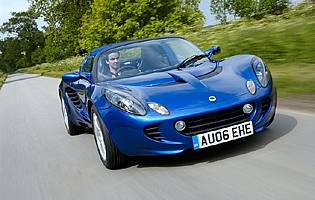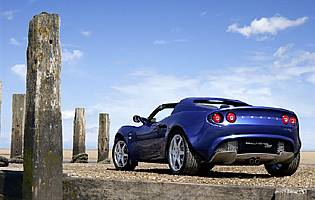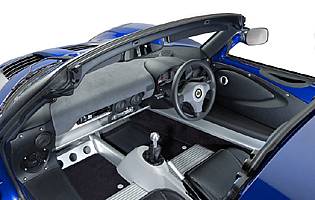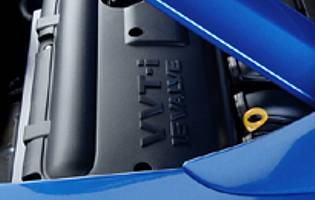



Overall rating
![]()
Elise S retains the unique styling of the rest of the range




![]()
Long renowned as a sports car manufacturer, Lotus's most important product is its Elise. Subtly revised in early 2006, the range has been widened further with the introduction of the Elise S, using a lower-powered 1.8-litre engine sourced from Toyota. Intended as an entry model, it still offers sparkling performance, and the reduced specification allows a much cheaper price.
From the outside there are few visible differences from the Elise R. It retains the low stance and curvy shape that all make it quite unlike any other sports car on the road. Subtle 'S' badging and simple eight-spoke alloy wheels set it apart from the higher specification R model, while it retains the simple fabric roof for top-down motoring.
Inside the stripped-down cabin remains, which includes the use of ProBax seats on all models. Designed specifically with posture and comfort in mind, they claim to put the spine in the correct position, improving comfort and blood flow to the benefit of alertness. The simple interior has small, chunky steering wheel with a high quality instrument pack, and a minimum of supplementary controls.
In practical terms the Elise is a strict two-seater, and offers little in the way of storage space. The boot is between the mid-mounted engine and the rear of the car, and although the area is a reasonable size and shape, the aperture is actually smaller than the space, making it difficult to carry rigid items.
The key change in the Elise S is the lower power output, and it also loses the variable valve lift, which in the higher output version results in a large power step at high revs. Although notable slower than the R, the S is still a quick car, and the more linear power delivery is more manageable in spirited driving.
The Elise is already a fantastic driving experience, and although the S model is essentially a lower spec version, this can add to the fun. With a less rev-happy engine, the whole rev range can be exploited and the balance of the chassis can be exploited more readily. Although it remains a car for the enthusiast with comfort and space compromises, in S form the Elise is even better value.
For the level of performance on offer, the Elise provides reasonable running costs. Driven with restraint the efficient 1.8-litre petrol engine can deliver decent economy as well as straightforward maintenance. Insurance may be an issue however, as it falls into the highest grouping.
The compact dimensions and intimate cabin leave little room for anything other than the two occupants. Once inside head and legroom are decent, although elbowroom is limited. A small storage area behind the seats and a boot behind the engine do give some room for luggage, but nothing larger than a sports bag will fit.
The minimalist nature of the Elise means the interior layout is refreshingly simple. The centre console houses only the ventilation controls which are stylish aluminium rotary knobs, although they are deep set which makes it difficult to see the top of the graduations. A small series of simple push buttons to the right of the steering wheel controls the lights, while the speedometer and tachometer are simple and elegant.
Although clearly not built for comfort, the ProBax seats deliver respectable comfort levels, even though there appears to be little padding. At lower engine speeds there is little noise from the petrol unit, but exhaust drone, tyre rumble and wind noise do intrude.
The Elise might appear to be a basic car but there's no shortage of protection on offer. The standard fit immobilizer package will ensure you car stays where you parked it, although the car's fabric roof can't possibly match the protection offered by a metal alternative. Anyone serious about theft prevention should consider an aftermarket tracking device as a secondary line of defence.
With outstanding grip, acceleration and braking performance, the Elise has an impressive level of active safety. Traction control is also available as an option. As standard the Elise is fitted with a driver's airbag, and four-point harnesses are available instead of regular seat belts in a bid to offer far superior support.
Anyone considering an Elise will be doing so purely because of its ability to deliver high levels of driving pleasure, and in this respect it is exceptional. The 1.8-litre engine has sharp throttle response, and despite the modest torque output has enough low down pulling power to accelerate smoothly. The stiff suspension comes into its own at speed, with virtually no roll to speak of and substantial grip. The steering is direct thanks to the lack of power assistance, and gives superb feedback. In ordinary driving the directness of the controls and the hard ride can be tiring, but when driving at speed it comes into its own.
A very small and enthusiastic family may enjoy the Elise's performance - as the second car in the household, but in all other respects a two-seat car such as this is unlikely to serve the needs of a family.
First time car buyers should steer clear of the Elise, however tempting its charms may be. Its high performance, sensitive steering and chassis and generally poor rearward visibility make it a car for experienced drivers only.
The lightweight construction of the Elise makes it more susceptible to rattles and noises that may be attributed to a lack of quality, but it is actually well finished from good materials. The image of the Elise is impressive, trading on its reputation as a superb car on or off the racetrack, and few rivals can match the cache of its badge.
Getting in and out of the Elise is quite a challenge and requires practice, as the door aperture is narrow and the car is very low to the ground - the roof is at waist height on most people. Once mastered it is less difficult, but still much more taxing than an ordinary car. Access to the boot is simple, although the aperture is much smaller than the boot itself.
The stereo unit fitted provides excellent sound quality and good station reception, although its regular size and mounting on the far side of the cabin can make it difficult to operate from the driver's seat.
The majority of the surfaces are black or silver, in plastic or bare aluminium, all of which are pleasant to touch, if cold when the outside temperature is low.
The Elise presents a number of problems when parking, most notably the restricted rearward vision. Forward vision is much better, but the steering is heavy at parking speeds, and that can make manoeuvres quite taxing for the driver.
Emergency inflation foam fitted beneath the bonnet - no spare wheel.
Petrol engine options: 1.6-litre (134bhp); 1.8-litre (220bhp). Transmission options: six-speed manual gearbox for all variants. Trim levels: base, CR, S (1.8-litre only).
Caterham CSR 200 Even more stripped down, delivers incredible driving experience
BMW Z4 Roadster Better blend of comfort and fun, styling not to all tastes
Porsche Boxster Impressive handling, expensive and less thrilling
Vauxhall VX220 Superb performance from turbo variant and excellent value for money